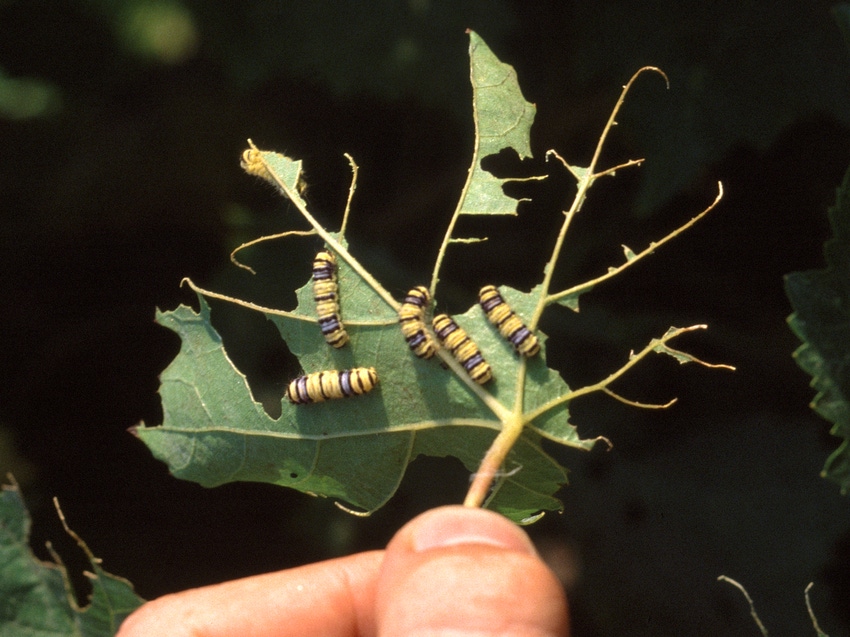
Western grapeleaf skeletonizer pest found in Napa County vineyard trap
The Napa County wine grape industry should be on the lookout for all larval (caterpillar) stages of the western grapeleaf skeletonizer pest, Harrisina brillians, following an adult found in Calastoga.“This is a destructive and serious pest,” says Greg Clark, Napa County Ag Commissioner.
July 6, 2015

Napa County Agricultural Commissioner Greg Clark asks grape growers and gardeners to keep their eyes peeled for all larval (caterpillar) stages of the western grapeleaf skeletonizer pest, or WGS.
This follows the June 24 discovery of an adult WGS in a vineyard pheromone-baited trap on Tubbs Lane in Calistoga.
“This is a destructive and serious pest,” Clark said.
He explained, “All larval life stages are voracious feeders that cause extensive damage to grape leaves, including partial or complete defoliation of grapevines.”
Excessive feeding can damage fruit and lead to secondary fungal damage and grape cluster rot.
Clark said, “We do not want this pest to become established in Napa County.”
Pest detection trappers from the Ag Commissioner’s Office were deploying 25 additional traps within a mile radius of the Calistoga find.
The pest is not native to Napa County but has been found in the county several times in the past. The last find was on Mt. Veeder Road in 2007. The pest, native to Arizona and New Mexico, was first discovered in California in the 1940s. It eventually spread throughout the state, especially in the Central Valley.
According to the University of California (UC) IPM website, western grapeleaf skeletonizer moths fly during the day and are metallic blue or greenish black in color.
The wing span is 1 to 1.3 inches with a .6-inch body length.
Pest easy to detect
Pest damage is easy to detect. When feeding on grapevines, the pest leaves only the veins, creating a very distinctive, lacy-skeletal appearance.
Typically, cooler coastal regions have two generations of the moth per year while three generations are typical in the Central Valley.
The pale yellow or whitish-capsule-shaped eggs are laid in clusters on the grape leaf’s underside.
After hatching, the UC IPM website says the larvae line up and feed side-by-side on the leaf underside until the early fourth instar stages.
The five larval stages are distinguishable by color; the first two stages are cream colored and the third stage is brownish. Larvae with two purple and several blackish bands are signs of the fourth and fifth stages.
Worker warning
Field workers should use caution in the vineyard as larvae have long black poisonous spines which can result in skin welts.
At larvae maturity, larvae crawl under loose bark or into ground litter where a dirty, whitish cocoon is spun to pupate.
According to UC, leaf damage from the first through fourth larvae instar results in only the leaf veins and upper cuticle remaining, giving a whitish paper-like appearance. The leaf eventually turns brown.
The late fourth- and all fifth-stage larvae skeletonize the leaves, leaving only the larger veins.
In large numbers, larvae can defoliate vines by July. When this occurs, larvae feed on grape clusters causing bunch rot, plus defoliation-caused fruit sunburn and quality loss.
The moth is not a long-distance flyer so it does not exist in all grape-growing regions.
Pest management
The western grapeleaf skeletonizer can be controlled with insecticides, says UC.
Biological control also works, including the Apanteles harrisinae and Amedoria misella (Sturmia harrisinae) parasites which attack larvae.
A granulosis virus has been successful in several areas.
UC says biological control and sprays of Bacillus thuringiensis and the Entrust formulation of spinosad are acceptable for organically certified grapes.
Report suspicious finds
Think you may have found a caterpillar or adult moth in Napa County? Clark says bring it to the Napa Ag Commissioner’s office or call at (707) 253-4357 to help identify it.
In addition, growers, vineyard managers, wineries, and residents who transport farm equipment or wine grapes into Napa County should inspect these items to ensure they are clean of this and other wine grape pests.
For more information and photos, visit the Napa County Agricultural Department’s website.
The latest western agricultural news to your Inbox - free Western Farm Press Daily E-Newsletter.
You May Also Like



